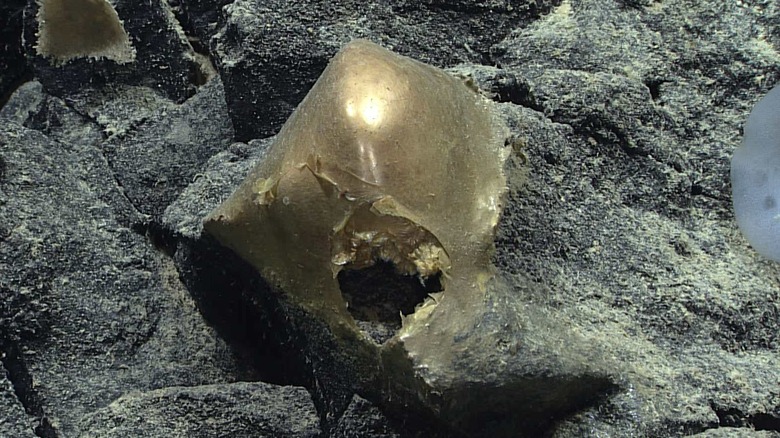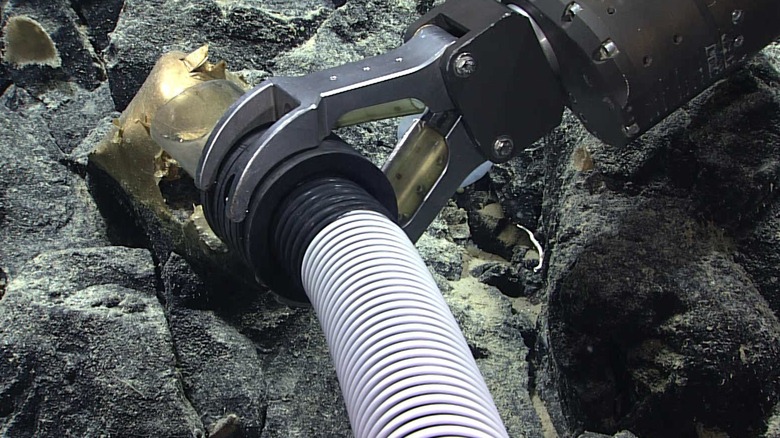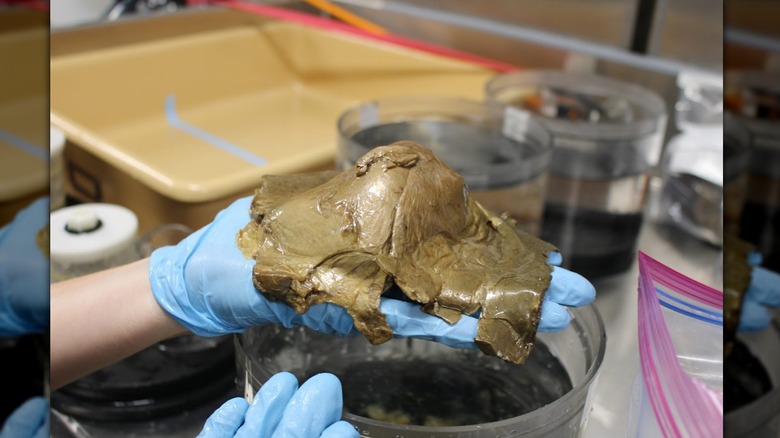Theories About What The Golden Orb Found At The Bottom Of The Ocean Might Be
Is it an egg, part of a sponge, or something else entirely? Those were the questions experts asked on August 30, 2023 when the remote survey vehicle Okeanos Explorer came across something unusual: a gold-colored spherical object. The find was located about 2-miles deep in the Gulf of Alaska, and scientists couldn't identify it, according to a press release from the National Oceanic and Atmospheric Association (NOAA). The Seascape Alaska 5: Gulf of Alaska Remotely Operated Vehicle Exploration and Mapping expedition made the discovery, exploring depths of up to 4 miles, and once spotted, the so-called golden orb was carefully suctioned up a tube and brought to the surface for closer inspection, The Guardian reported.
Affirmed to likely be of biological origin, theories as to what the "yellow hat" might be include an entirely new species, or a life stage of a known species science was unaware of. It measured about 4 inches in diameter, was stuck firmly in place, and once in the lab, the object appeared to be a yellowish-brown color. It was reportedly flesh-like in texture, and there was a hole in the object like a creature had escaped or tried to crack it open like an egg. In the early going, though, the golden orb otherwise had science stumped. One expert told The Guardian, "I just hope when we poke it, something doesn't decide to come out. It's like the beginning of a horror movie."
The sponge hypothesis
The mysterious golden orb was discovered amidst white coral, and one objective of the remote vehicle expedition was to explore deep-sea coral, fish, and sponge habitats, NOAA said (via The Washington Post). According to NOAA Fisheries, there are 52 known sponge species in the Gulf of Alaska, with many more that have yet to be identified. Deep-sea coral reefs are also widespread in the area, NOAA Fisheries elsewhere writes. Underscoring the real possibility the orb might belong to or be part of a whole new kind of animal, 5,000 previously unknown deep-sea species were identified in the Pacific between Hawaii and Mexico just months before it was found, The Guardian reported,
On the benefits of a possible new species, NOAA Seascape Alaska 5 expedition coordinator Sam Candio said, "New species have the potential to reveal new sources for medical therapies and vaccines, food, energy, and other societal benefits and knowledge. Collectively, the data and information gathered during this expedition will help us close gaps in our understanding of this part of the planet, so we can better manage and protect it."
The egg theory
A possible new species aside, the golden orb might also be an egg or part of an egg, as mentioned, and several known species are known to lay their eggs on the ocean floor where the object turned up. University of Plymouth deep-sea ecologist professor Kerry Howell told The Guardian she thinks the find is likely an egg — but if so, there's still mystery to solve. "We're going with egg because of the texture," she said. "It felt fleshy and it doesn't have any obvious anatomy. It has a hole in it that suggests something has come in or gone out. But it doesn't look like any egg I've ever seen. If it is an egg, the really interesting question is whose egg is it. It's quite big. That's not a small fish egg. That's a sizable thing."
Once back at the lab, DNA testing will likely reveal the golden orb's true story. Until then, expedition coordinator Sam Candio called it "somewhat humbling to be stumped by this finding." He continued (via NOAA), "It serves as a reminder of how little we know about our own planet and how much is left to learn and appreciate about our ocean."


